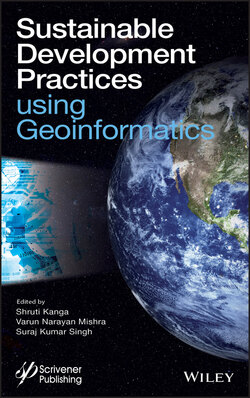Читать книгу Sustainable Development Practices Using Geoinformatics - Группа авторов - Страница 41
2.4.3.1 Geo-Environmental Hazard Index
ОглавлениеThe geo-environmental hazard map was derived by combining AOT, PWV, temperature, and LU/LC of the study area. The computed hazard index indicates the areas, which are more prone to be hazardous (Figure 2.6). The range of index values for the geo-environmental hazard model (that uses four hazard parameters) is 3–13. Natural Breaks (Jenks) classification technique was used to divide the ranges into four zones such as low (3–5), moderate (5–7), high (7–9), and very high (9–13).
Figure 2.6 Composite geo-environmental hazard index map of the study area.
Figure 2.7 Composite socio-economic vulnerability index map of the study area.
The geo-environmental hazard map shows that about 13.93% and 18.93% of the area lie between very high and high hazardous zones and the remaining 43.28% and 23.86% of the area fall in the moderate to low hazardous zone (Table 2.2). The highly hazardous zones are present in the eastern and south-eastern parts covering an area of 125.27 km2 (Figure 2.6). A possible reason for highly hazardous prone regions is that they were attributed greater AOT and PWV concentration along with location of active coal mining and several sponge iron industries. The majority of the study area lies in the moderate hazardous zone (164.85 km2) that is in the central part of the region, whereas the lowest hazardous areas are mostly the forest and hilly areas (90.88 km2).
Table 2.2 Area statistics of socio-economic vulnerability index in study area.
| Socio-economic Vulnerability Zones | Area (km2) | % Area |
|---|---|---|
| Low | 32.84 | 8.62 |
| Moderate | 111.95 | 29.38 |
| High | 210.89 | 55.35 |
| Very High | 25.33 | 6.64 |
| Total | 381.00 | 100.00 |
